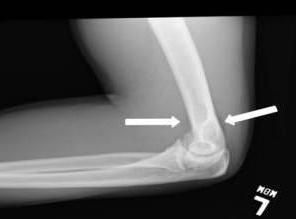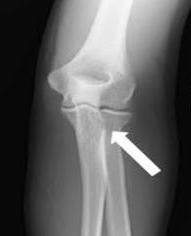- Clinical Technology
- Adult Immunization
- Hepatology
- Pediatric Immunization
- Screening
- Psychiatry
- Allergy
- Women's Health
- Cardiology
- Pediatrics
- Dermatology
- Endocrinology
- Pain Management
- Gastroenterology
- Infectious Disease
- Obesity Medicine
- Rheumatology
- Nephrology
- Neurology
- Pulmonology
FOOSH Injury of the Elbow
FOOSH injuries associated with acute onset of pain at the elbow suggest fracture of the radial head, proximal ulna, or humeral condyle or soft tissue injury.

A 27-year-old man presented for examination a day after sustaining a FOOSH (fall on outstretched hand) injury while roller skating. He complained of pain when pronating and supinating his left arm, but there were no limitations in range of motion. A lateral plain x-ray film shows an anterior and posterior fat pad sign on the left elbow (Figure, left). A second image of a posteroanterior view also revealed a slight hematoma positioned medially and just inferior to the radial head (Figure, below). Superficial bruising was also noted on the medial aspects of the distal humerus and proximal ulna bones. Initial suspicion of occult fracture was ruled out by orthopedic evaluation. No radiographic study of the wrist was performed. Recommended treatment was 600 mg of ibuprofen by mouth twice daily, combined with short-term immobilization, elevation of the limb, and rest. Recovery was unremarkable and without sequelae.

FOOSH injuries associated with acute onset of pain at the elbow raise the suspicion of fracture of the radial head, proximal ulna, or humeral condyle as well as soft tissue injury. Elbow pain associated with decreased range of motion, ecchymosis, point tenderness, and radiographic findings will help narrow the differential. A positive fat pad sign noted on a lateral plain film of the elbow is suggestive of an intact joint capsule that is distended as a result of hemarthrosis or joint effusion. Distention of the joint capsule leads to displacement of the fat pads on the anterior and posterior aspects of the distal humerus, which is noted as a darker, radiolucent space adjacent to the bone on plain film. This distention of the joint capsule may occur as a result of acute trauma, inflammation, infection, or neoplasm.1
Reference:
1. Goswami GK. Signs in imaging: the fat pad sign. Radiology. 2002;222:419-420. (Free full text)
